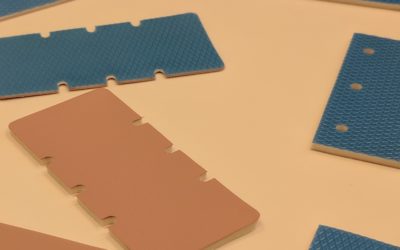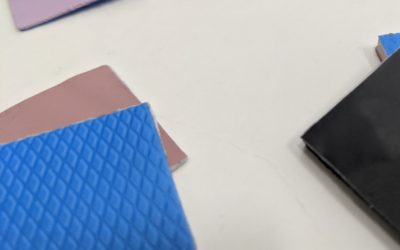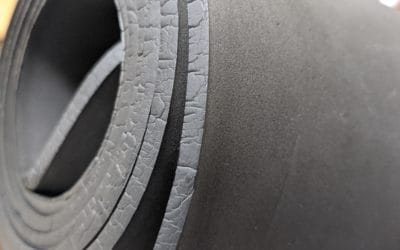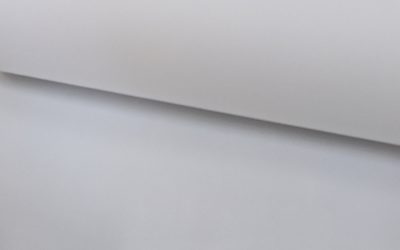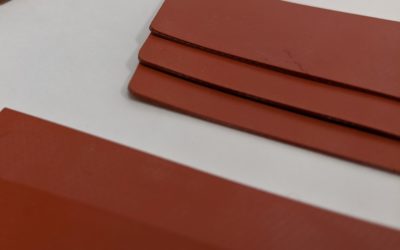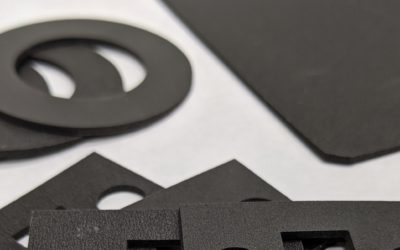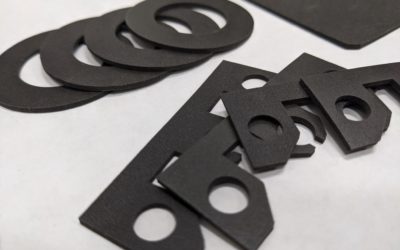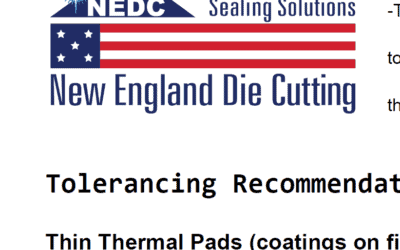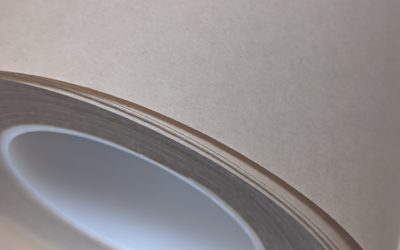Waterjet Cutting
Foam, Solid Gaskets, Thermal Pads, Absorbers, and Electrical Insulators
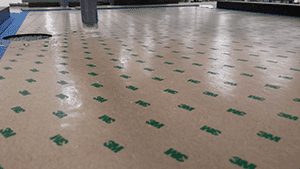
Waterjet Cutting PSA-backed Neoprene Gasket
NEDC operates only with state-of-the-art equipment that can handle a wide variety of materials. One of the most sophisticated machines NEDC owns is our Waterjet Cutters. Waterjet Cutting happens through a very unique process. The process starts with a high-powered pump that creates a lot of pressure for the water. The water then exits the head of the waterjet through a premounted sapphire/diamond orifice. All of this action produces an extremely powerful waterjet stream that is forced from the head at incredible speeds, (30,000-50,000psi). This streams pierces the gasketing material creating a clean cut with the most available commodity on the planet, water. The waterjet cutting process allows parts to be nested in a very economical fashion. NEDC is a leading waterjet cutting supplier for gaskets, insulators, and other elastomeric products such as thermal filler pads, or absorbers.
Foam/Sponge Gaskets:
Foam or Sponge gaskets are also cut with our waterjet machine. These materials can be flexible and cause issues in conventional die-cutting. This is due to the elastic nature of these materials; causing the material to snap-back into an hourglass like shape. However, with a waterjet focusing on one hole/feature/cut at a time, meeting tolerance requirements becomes easier.
Solid Rubber Gaskets:
At NEDC, the main function of our waterjet is used to cut solid gaskets. These gaskets can range from nitrile rubber, to neoprene rubber. The reason we do this is because typically when our customer is looking for a few gaskets, we can make them quickly and accurately on our waterjet. It also helps us dial in tight tolerances. Some of these materials include neoprene, fluorosilicone, silicone, nitrile, EPDM, or other conventional rubber materials.
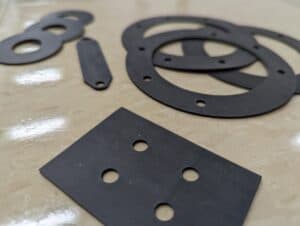
butyl custom gaskets
Advantages of a Waterjet Cutting Machine:
- Extremely Accurate Cuts of Complex Parts
Waterjet cutting offers an incredible amount of accuracy through a coordination of computer software and tight controls. Tolerance can be held as +/- .002” on some materials.
- Maximizes Yield of material through nesting software
Parts can be easily nested to offer our customer the best price possible. In some situations, when a part has a very unique geometry, sometimes the way it may be nested is not quite as linear as a simple horseshoe like part. In these cases, waterjet machines are able to flip, turn, and match the shape in many different directions utilizing every inch of material.
- No tool investment is necessary for water jet cutting
No tool is needed to be made, the DXF is the tool! Please provide an electronic file to aid in programming/cutting. This saves time and money because this file is cut to your specifications.
- Quick Prototypes
At NEDC, we strive to provide prototypes quickly. Waterjet Cutting offers the advantage of the customer being able to engineer the part through their DXF and see what the part will look like in production. The benefit of creating a DXF gives a side benefit of being able to move into production in a much quicker fashion by reducing the time between each prototype rendition. No tool is required to be created, so parts can be cut extremely fast.
- Cut parts from CAD/DXF files, to ensure perfect accuracy of every cut, every time. High degree of repeatability
The DXF is executed by the software in the waterjet cutting machine. When cutting with a DXF file, you can guarantee that no tool will wear/abrade. The waterjet stream itself is always offering a consistent water stream that makes each part nearly identical to the last. This makes reproducibility a huge asset for the machine.
- Allows materials to be cut without the typical compression of conventional die-cutting
Die-Cutting thick foam/sponge materials can result in concavity because of the “burst” action of the die; with a waterjet it is possible to avoid this compression distortion because the waterjet is not compressing the material in the way a conventional die cutting operation would. The difference is, it is slicing through the material in a vertical direction.
- Size of gaskets/parts has little limitations
Cutting gaskets has nearly no limitations when it comes to custom. However, size becomes a concern the bigger the gasket becomes. With waterjet cutting, the only limitation becomes the size of the bed of the waterjet itself. With that said, NEDC has cut 7 foot gaskets before on its waterjet machine.
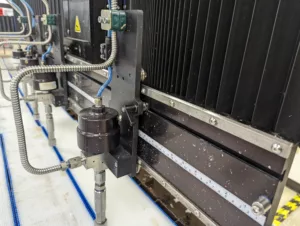
waterjet cut sponge/foams
Limitations of a Waterjet Cutting Machine:
- Size of parts have limitations
While we just said above that bigger gaskets are easier to cut with a waterjet- as it gets smaller, it may become more difficult. This is because the waterjet stream has a size too, and that starts to limit the features it can cut with accuracy. If the stream and the feature become competitive in size, it can become a challenge.
- Amount of parts being cut
While waterjet cutting is pretty quick, the amount of parts being cut can become a challenge because as mentioned above, cutting with a waterjet only works on one feature at a time. This is in comparison to die-cutting that cuts everything all at once. This is one of the tradeoffs when using a waterjet cutting machine. This drawback generally falls under speed of the overall process.
- Some materials just do not work
Some materials just do not cut well on a waterjet. Fibrous, or otherwise paper like products generally have a tough time cutting because either they soak up the water or they explode when cutting them. Other materials that we know do not work is anything that is impregnanted with wire in a perpendicular direction to the material. It is wise to consult with an experienced waterjet operator before asking a part to be waterjet.
If you have a gasket/part that you believe could be waterjet cut, please send your question or drawing to sales@nedc.com. NEDC has experienced waterjet operators that understand what the machine can do well.
Waterjet Cutting Blog
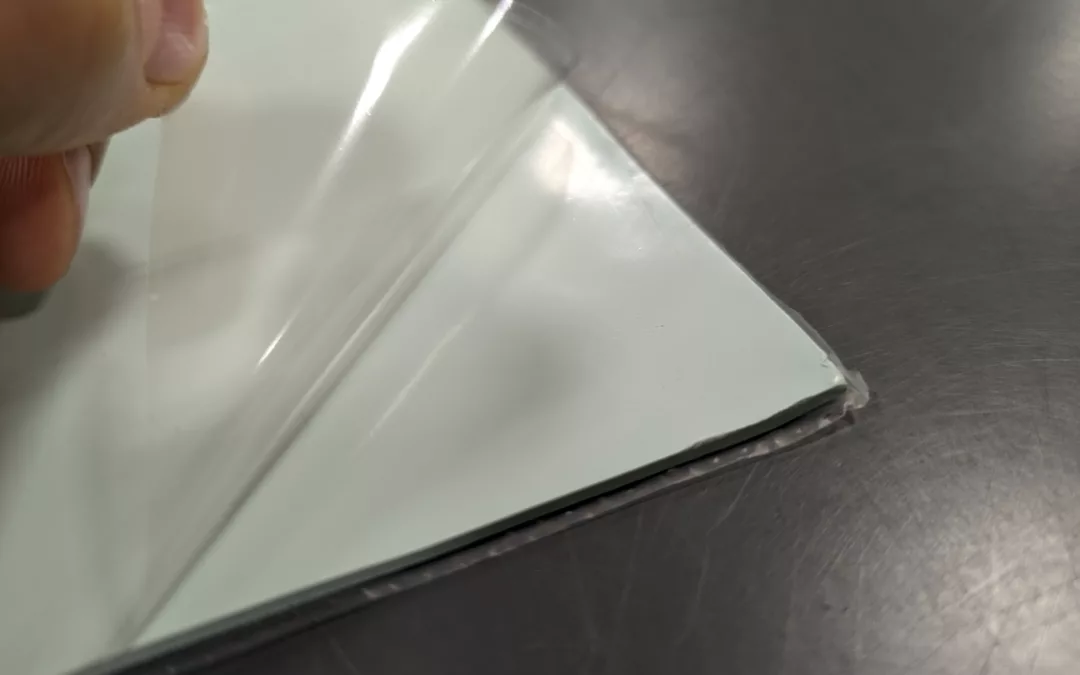
T-Global Technology | Thermal Gap Pads | Thick, Thin, High W/m-K
At NEDC, thermal pads are our specialty. Our manufacturing site is in Methuen, MA. Across the pond, in the United Kingdom, there is a reputable thermal pad manufacturer. This manufacturer is called T-Global Technology. They make a number of thermal interface...
Previous Posts
IP Ratings – Gaskets & Ratings | Particles/Liquid Ingress
IP (Ingress Protection or International Protection) ratings are a common...
TFLEX 600 | High-Compliance Thermal Pads | Low-Stress
NEDC manufactures thermal pads for many different customers. The thing I...
Passivated Silver Aluminum EMI Gaskets | Custom Cut Gasket
NEDC manufactures gaskets of all sorts. Our arena of play in the gasket...
3 Tips for Selecting a Thermal Gap Filler Pad!
Many of our customers are using thermal pads nowadays. With another year in the books, the electronics used this year are at an all-time high. This requires more cooling! To finish off the year, we thought we would make a blog about a few tips on choosing a thermal...
What do we make at NEDC?
A lot of times when I’m explaining to someone what I do for a living, I almost feel like saying “I play with giant cookie cutters all day.” We Use Giants Cookie Cutters, why say this? To most people it seems hard to explain that our customers just send me a print and...
Outgassing of Thermal Pads | ASTM E595 | TML & CVCM
One of our tips for selecting a thermal pad is selecting a thermal pad that has a lot of data about it. Some of these data points include, thermal conductivity, volume resistivity, flame rating, Young's Modulus, and more. However, one common question when it comes to...
Sponge/Foam Rubber Blends | Die-Cut, Waterjet-Cut, Lamination
Closed Cell Sponge/Foam rubber materials have a place in the industry. Oftentimes they are used in applications where either for vibration dampening, or gasketing where not much compression force is available. However, there are also times where the environmental...
ITW Formex | Die-Cut/Laser-Cut Parts | Scored, Formed, Bent, Cut
Electrically Insulating materials are a common die-cut product here at NEDC. One of the more common materials we use is ITW Formex. These insulating plastic materials are used in a number of electrically isolating applications. They are flame retardant, and are...
Reinforced Silicone Rubber Gaskets | Silicone Solid, Sponge Rubber
One of the issues in die-cutting is what we call “thin walls” this occurs when there is a hole close to the wall of a part. We typically implore our customers to allow for “break-out” if possible. However, when a gasket is reinforced, it can make this problem easier...
Thermal Insulation | Silicone Foam Rubber Materials
At NEDC, thermal management is close to our core as a company. Most times when companies think of thermal management, they think of Thermal Gap Filler products. The opposite problem to solve is making sure heat doesn’t go in a certain direction. Gap Fillers direct it,...
AquaPro™ PORON® by Rogers Corporation | Water Sealing Polyurethane Foam
At NEDC, watertight seals are a common product we sell. Customers come to us for all sorts of gasketing materials that are good for watertight seals, including silicone rubber, neoprene, and other commonly known gasketing type materials. Separately, customers...
Super-Soft Silicone Rubber Gaskets | Tight-Tolerance/High-Temperature
At NEDC, Custom Silicone Rubber Gaskets are a common product we sell. Included in that category are the Super-Soft Silicone Rubber Gaskets that are available. When I think soft gaskets, typically below 40A durometer would be considered soft. However, when I think of...
Top 3 Reasons to Choose PORON for your Gasket! | Dust Sealing
At NEDC, dust seals, and gaskets are a main product we offer our customers. It can be difficult to find an effective gasket that meets your price range, but is also tough enough to get the job done with little hassle. Luckily, Rogers PORON® gets the job done. In this...
Tolerancing for Thermal Pads | Thickness, Diameter, Linear Dimensions
One difficult thing for the team is when a tight tolerance is put on a thermal interface material. Some of our customers understand, gap filling materials are putty like. Alternatively, thin thermal pads are usually coatings coated on a reinforcement layer such as...
Double Coated Tape by 3M Company | What is a Double Coated Tape?
At NEDC, we use double coated tapes for a variety of purposes. Sometimes we use it as an aid in manufacturing- other times, we provide it to customers either laminated to a gasketing material, or perhaps just the double coated tape itself. What is a Double Coated...
All of the information presented above is believed to be factual and accurate; however, NEDC is not liable for any design or application utilizing this information.
New England Die Cutting
Capabilities/Products
Quick Links
Popular Blog Posts
No Results Found
The page you requested could not be found. Try refining your search, or use the navigation above to locate the post.
